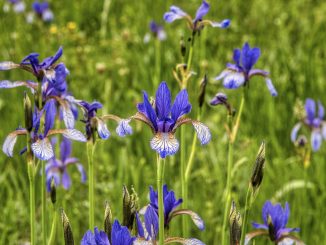
Contents
The Carthusian pink was cultivated as a medicinal plant in monastery gardens early on. During the flowering season in summer, the native pink species is a magnet for butterflies in the garden.
Profile of Carthusian pink:
Scientific name: Dianthus carthusianorum
Plant family: pink or carnation family (Caryophyllaceae)
Other names: –
Sowing time: autumn
Planting time: spring
Flowering period: June to September
Harvest time: April to September; flowers, sap
Location: sunny
Soil quality: stony to sandy, calcipholous, low in nutrients
These information are for temperate climate!
Use as a medicinal herb: muscle pain, rheumatism, snake bites, skin diseases, toothache
Use as spice herb:
Use in: flower meadows, dry stone walls, overgrowing, apothecary garden, roof garden, heather garden, natural garden, rock garden
Winter hardiness: hardy, USDA Plant Hardiness Zones: 3 (-37 °C / -35 °F)
Bee and insect friendly: Yes
Plant characteristics and classification of Carthusian pink
Plant order, origin and occurrence of Carthusian pink
The Carthusian pink (Dianthus carthusianorum) can be found in nature in almost all parts of Europe. It grows mainly on chalky, sandy or stony soils, on heaths, in pine forests and on slopes with dry grass. The wild shrub belongs to the pink family (Caryophyllaceae). It probably owes its name to the Catholic reclusive order of the Carthusians, who cultivated the undemanding carnation early on in their monastery gardens.
Characteristics of Carthusian pink
Plant
The short-lived wild shrub grows from a basal rosette of leaves with upright, wiry shoots that reach heights of 15 to 45 centimeters (6 to 18 in). It forms loose polster over time.
Leaves
The narrow, linear, almost grassy foliage of Carthusian pink is about 5 centimeters (2 in) long. The dull green leaves sit opposite to each other on the shoots and are fused together in the stem area.
Blossoms
Typical for carnations are terminal, head-shaped inflorescences with several individual flowers; 7 to 15 flowers sit together in such a head. The individual flowers have a round, radially symmetrical shape and five purple-red, serrated petals that are fused to form a tube at the base. The flowers are about 2 centimeters (0.8 in) in diameter and have a sweet smell. There is a brownish, dry-skinned calyx around the flower. Dianthus carthusianorum blooms from June to September.
Fruit
Capsule fruits develop from the pollinated flowers, with numerous, very fine seeds that open when ripe.
Carthusian pink – cultivation and care
Location
Carthusian pink likes warm places in full sun.
Soil
The Carthusian pink grows best on sandy, permeable soils with a neutral to basic pH value. It is important for the plants that there occurs no waterlogging.
Planting
The best time to plant Dianthus carthusianorum is spring. Place the plants in small groups of three and keep a distance of 20 centimeters (8 inches) from each other.
Care
If you cut back the Carthusian pink after the main bloom, a second bloom can be favored. Otherwise, the plant does not require intensive care, neither fertilizers nor additional watering.
Propagation
The Carthusian pink seed itself abundantly and thus mostly ensures its own propagation. It is therefore well suited for overgrowing in near-natural plantings. You can also sow the carnation in a targeted manner. Simply harvest the ripe seeds after the flowering period in September and sow them in the desired location in the garden. The perennial needs light to germ.
Diseases and pests
The wild perennial is robust and insensitive to plant diseases. It is also avoided by snails.
Wintering
The Carthusian pink is hardy down to -37 °C / -35 °F and does not require any special winter protection measures.
Use
In the garden
As a plant for dry grass, the Carthusian pink is particularly recommended for rock gardens, potted gardens, the crown of dry stone walls and for roof greening. Suitable companion plants with the same flowering time are, for example, earleaf bellflower, baby’s breath and quaking grass.
The flowers are ideal for the long proboscis of butterflies such as skipper or the brimstone butterfly. These and other butterflies like to come to the flowers in summer to suckle nectar.
Varieties
There are no cultivations of the Carthusian pink, but some subspecies that differ little from the wild species and are geographically limited. These include, for example, the pre-Alpine Carthusian pink (Dianthus carthusianorum ssp. Alpestris) in higher mountain regions of Austria or Dianthus carthusianorum ssp. sudeticus, which only grows in the Czech Republic.
Carthusian pink as a medicinal herb
The Carthusian pink contains saponins and eugenol in all parts of the plant and has an analgesic and anti-inflammatory effect. Chewing the flowers is said to relieve toothache, even if the content of eugenol in the clove is higher. To relieve rheumatism or muscle pain, the fresh plant can be mashed into a paste that is applied to the affected areas of the skin. The pink is also part of tea blends.
Blossoms
Chewing the flowers for toothache, crushed flowers against snakebites.
Fresh juice
Externally against skin diseases, rheumatism and muscle pain, internally against plague and worms.
Carthusian pink can be used for these ailments and diseases
- muscle pain
- rheumatism
- snake bites
- skin diseases
- toothache
Medicinal properties
- analgesic
- anti-inflammatory
- emollient
- pain reliever
Side effects
Not known.
Disclaimer:
Ask your doctor or pharmacist. Visiting this page can not replace the visit to the doctor. For serious or unclear complaints, consult your doctor.




Leave a Reply